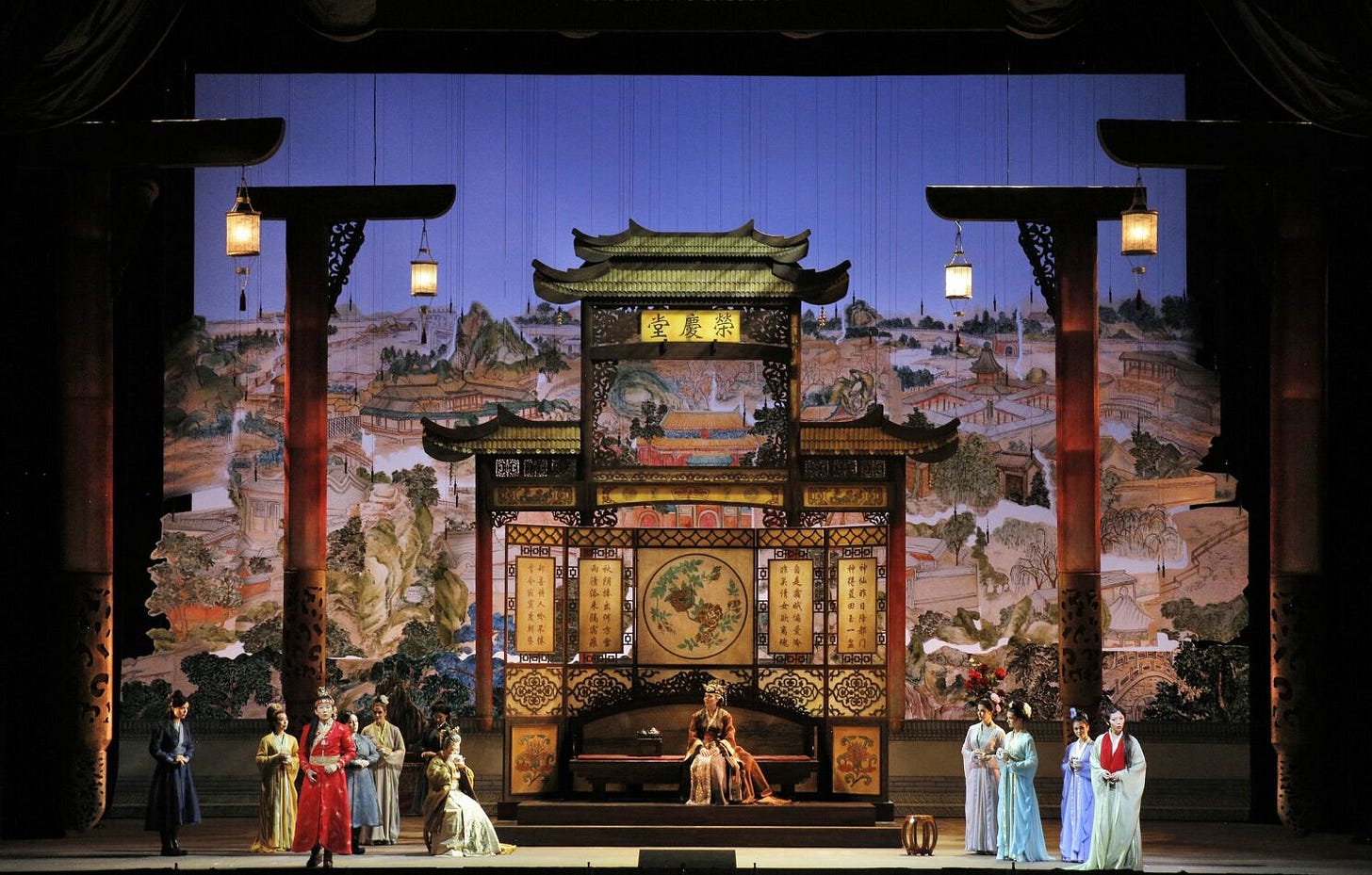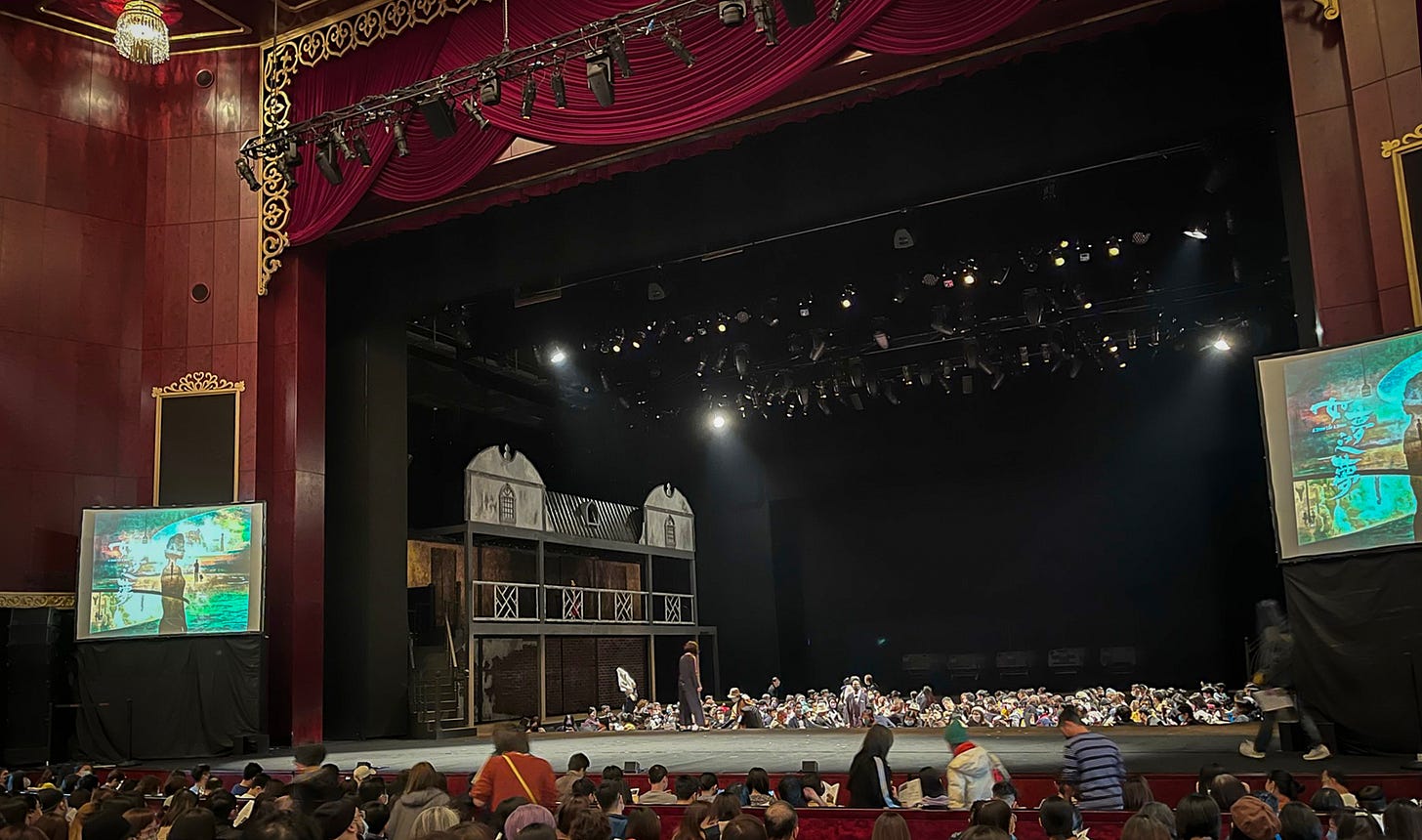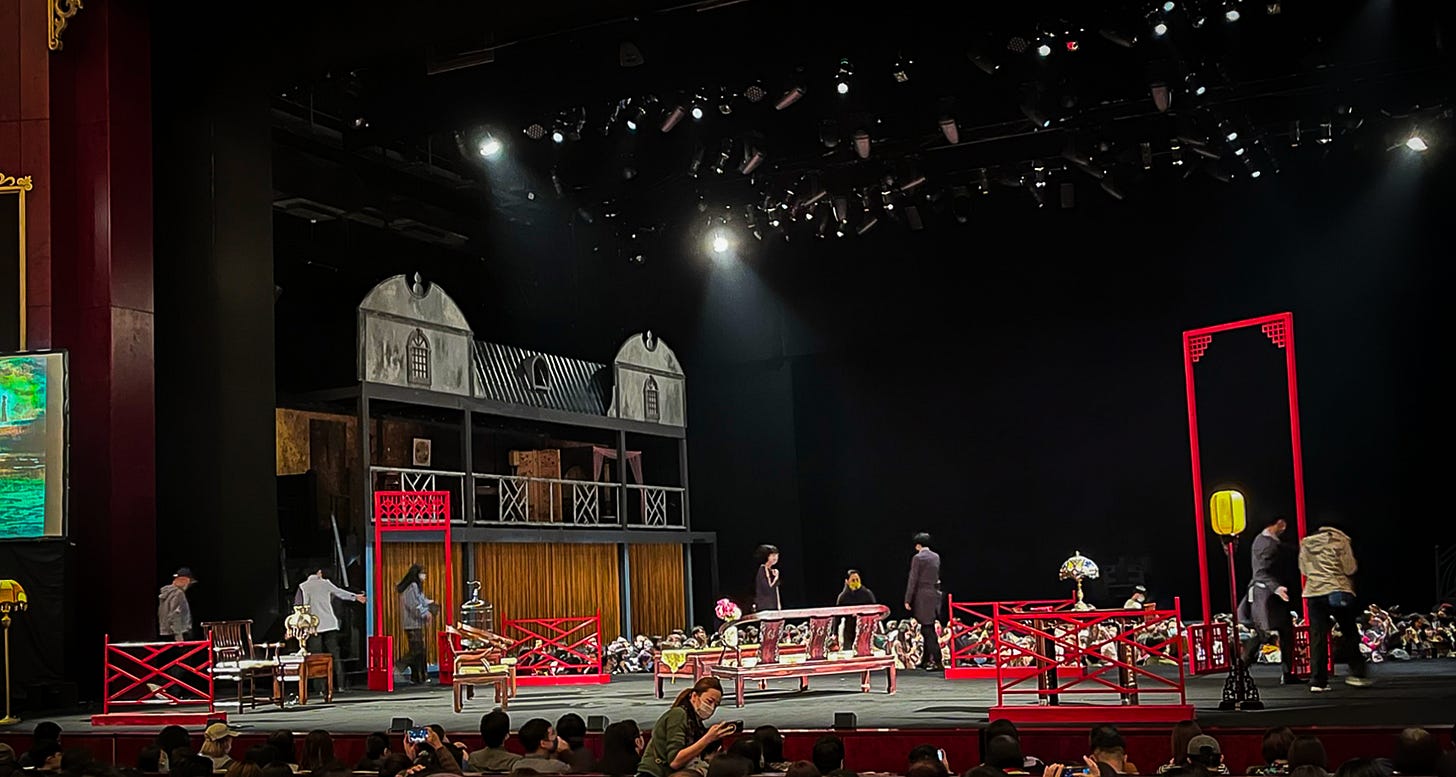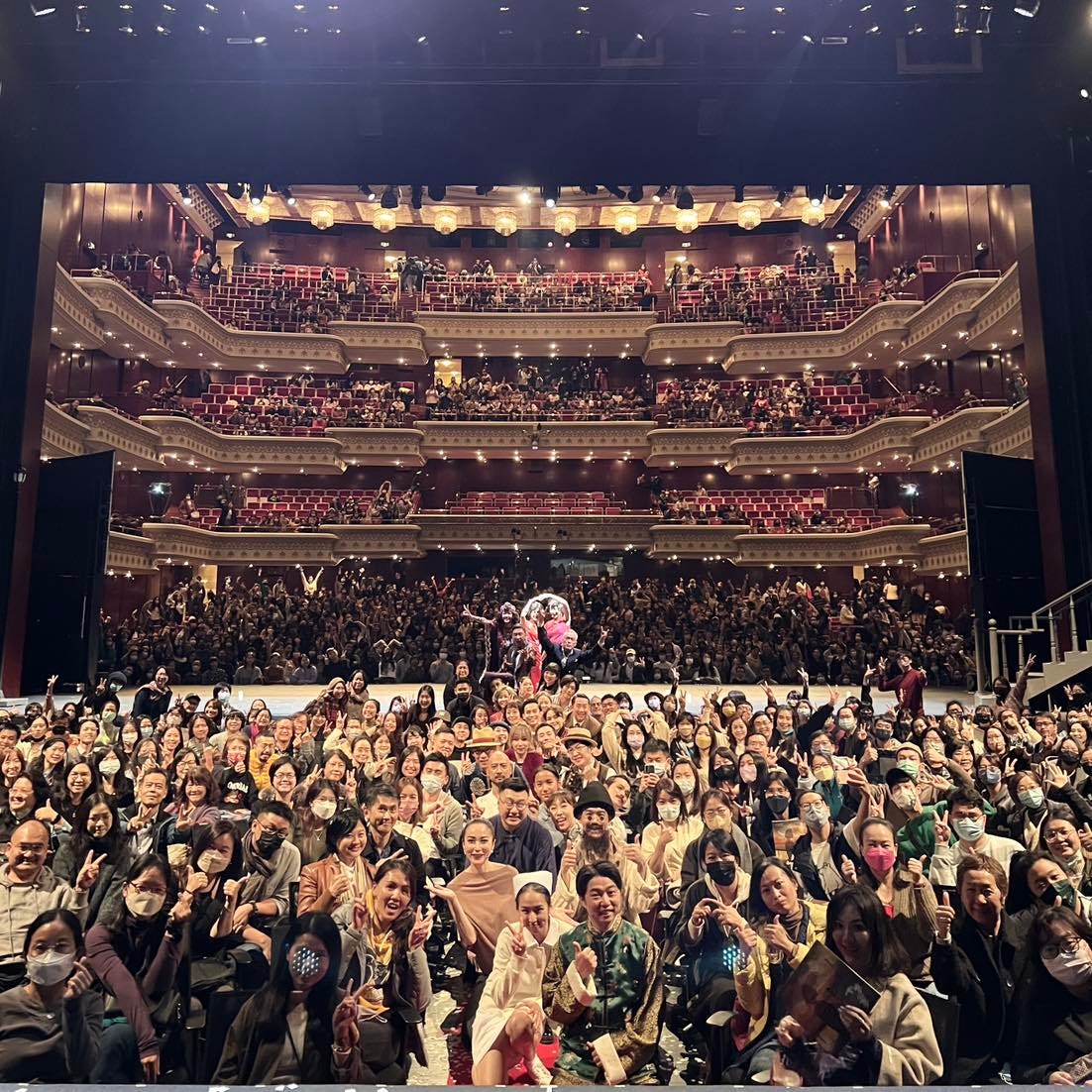Well, all, I’m back, albeit far behind the schedule I had hoped for. As penance for being so remiss these past few weeks, this post is a long one. I’m taking the opportunity of this particularly long post to think through the creative process of large-scale theatrical productions, the ethics of theatrical critique, and the economic considerations that many artists today confront as they make decisions about how to leverage their art (or not) for social good. As such, it’s a topic that’s near and dear to my heart, and I hope some of you will still be able to give this piece a read.
When my good friend Charlotte came to Taiwan to visit me a couple of weeks ago, I did not anticipate that one of the activities on her bingo card would be a 10-hour theatrical performance in Mandarin. Nevertheless, when she suggested we go together to watch A Dream Like a Dream 如夢之夢 by Stan Lai 賴聲川, I leapt at the chance to lock myself into Taipei’s National Theatre 國家戲劇院 for almost exactly that amount of time.
Part of what made me particularly eager to go to this performance was the fact that, although this was my first time seeing a play written by Stan Lai, it was not my first exposure to his directorial work. In fact, my first experience of Stan Lai’s work was in 2016, when saw the San Francisco Opera’s premiere of Bright Sheng’s Dream of the Red Chamber, setting a libretto by David Henry Hwang, and directed by none other than Stan Lai.
As part of my first Stan Lai experience, I was able to attend a set of public lectures about the production process of Sheng’s opera, including a talk by Stan Lai. In comparing Lai’s work as an opera director and a theater director, I feel like we can gain some purchase in the different processes, hierarchies, potentials, and limitations that are baked into different theatrical genres. This comparison also gives us the opportunity to consider the critical potentials—and limitations—of contemporary, commoditized arts.
First, though, a little bit about the director. (Basically, I’m going to condense the Wikipedia article for y’all … )
Theater Director Stan Lai
Stan Lai 賴聲川 is widely known as one of the most influential theater directors in the world today. His roughly 40 plays (many of which he has translated into English) and two award-winning films grow out of an artistic process that draws heavily on improvisatory rehearsal techniques. Born in the US in 1954 to Taiwanese parents who were serving at the ROC’s Embassy in Washington DC (remember, Taiwan in 1954 was “China”), Lai ultimately earned a PhD from UC Berkeley, followed by a period of training with Dutch theater director Shireen Strooker. Lai ultimately leveraged these credentials to secure a professorship in Taiwan, becoming one of the earliest faculty members at the Taipei National University of the Arts 國立臺北藝術大學 (which just so happens to be my host institution here in Taiwan).
In 1984, Lai co-founded the Taipei-based theater company Performance Workshop 表演工作坊, which today focuses primarily on his works. In 2015, Lai opened the Shanghai-based Theatre Above 上剧场, a custom-built space that is devoted entirely to the playwright’s works. All of these artistic endeavors have earned Lai a host of accolades (Google him), and have launched a booming trade in the academic study of Lai’s plays. In addition, Lai’s works have toured almost continuously in Mainland China since the mid-2000s (more on that later).

In the West, Lai’s reputation is largely based on his success as the director of the 1992 film Secret Love for the Peach Blossom Spring 暗戀桃花源, as well as his extended teaching stints at Stanford and UC Berkeley. But in Asia, as well as in the broader critical and academic community, his reputation remains firmly rooted in his activities as a theater director, with Robert Brustein (founder of the American Repertory Theater and the Yale Repertory Theater) calling him “the major contemporary Asian playwright of his time, perhaps of all time.”1
But even great theater directors have their limitations. In the case of Lai, I would argue that having first encountered Lai’s work in opera, my introduction to the director was quite a bit outside his comfort zone. As such, I was introduced early to the limits of his creative process.
Dream of the Red Chamber: Betwixt Theater and Music
When I went to see Bright Sheng’s Dream of the Red Chamber, it had the feel of a major moment in the US operatic community. It was the first major adaptation for Western audiences of the 18th-century Chinese novel of the same name (Hong lou meng 紅樓夢), providing English-speaking audiences with a loose adaptation and translation of one of the novel’s major plot lines.
In addition to Bright Sheng’s headlining world premiere, SFO had assembled a “Dream team” creative staff (get it? *Dream* team!), featuring director Stan Lai, librettist David Henry Hwang, and production designer Tim Yip (most recognizable to Western audiences as the Academy Award-winning art director of Crouching Tiger, Hidden Dragon 臥虎藏龍). Add to this the fact that this was a rare instance in North America of an all-Asian production team and all-Asian cast of leading singers being recruited to tell an Asian story, there was a general buzz around this premiere that is rare in my experience of America’s canon-reliant big-budget opera houses.

But in the series of talks held at UC Berkeley in advance of the performance, I found Stan Lai’s discussion to be particularly revealing of the differences between theater and opera. In response to a question about what the director thought of Bright Sheng’s score, Lai said something along the lines of, “It has nice moments, but there’s just too much music. Sometimes my staging is done, and there’s still a lot more music left.” (To be fair, Lai also singled out Mozart’s operas for the same problem of “too much music.”)
Unfortunately, Lai’s opinion that Sheng’s opera suffers from an overabundance of music was reflected in much of the show’s staging. Lai’s singers were given enough staging to express what Lai wanted to express, and then left to stand and fill time. While some singers had the experience and nerve to do this (such as tenor Shi Yijie 石倚洁, below), many of the production’s younger singers ended up looking very lost on a very large stage, seriously undermining an otherwise stunning production.
But Lai’s musical ambivalence also reveals conflicting (contradictory?) visions of the artistic hierarchies of theatrical productions. In Lai’s vision of theater, a director initiates an improvisatory process that harnesses the improvisatory energies of their cast, which ultimately coalesces in the form of a script that the director then refines and shapes to meet the needs of their own creative process. In this model of theater, the director is the creative mastermind whose artistic prowess draws a production’s disparate elements into a cohesive whole.
In contrast, the composer is the apex predator of the operatic ecosystem. Where musical theater scores are built to facilitate vamping, cutting, transposing, and rearranging, operatic scores today are generally regarded as complete works that cannot be trimmed and amended willy-nilly.2 Opera singers are trained to fill that music, to try and read compositional intent into the music and create stagings that reflect that intent.
Refusing to read into the totality of the aural landscape created by one of the most influential living composers working today doesn’t just reject the artistic hierarchies in one of theater’s sister fields, nor does it simply abandon singers to fend for themselves on stage (although in this case it certainly accomplished both these things.) Rather, it also implicitly demands that all theatrical forms approach the aesthetic and dramatic ideals with which Stan Lai approaches his own works. And while Stan Lai has achieved nearly transcendent results working within his own preferred parameters, it seems to me that a dogmatic adherence to one set of aesthetic principles (whether intentional or otherwise) simply impoverishes the entire theatrical landscape.
At this point, though, it’s worth asking, what exactly is Lai’s preferred approach?
A Dream Like a Dream: Theater in the Extreme
Lest it look like I’m here to take a hatchet to Stan Lai’s work, let me be clear: A Dream Like a Dream was one of the most remarkable theatrical experiences of my life. Including a dinner break, the ten hours of theater interweaves the stories of dozens of characters, almost all of which are played by multiple actors. Lai uses this device of multiple actors playing the same role flexibly. Sometimes different actors play the same character at different ages. At other times, the different actors simply play the same character in different situations, making it possible for characters to comment on their own actions, or to switch between scenes/costumes with a speed normally reserved for cinema.
This was also clearly The Theatrical Event of the Year™ in Taiwan’s theatrical community. Many of the actors involved in the production are major stars in their own right. Even minor roles were played by famous actors. Remember when I talked about La grande chaumière violette 紫色大稻埕? Well, the lead actor of that show played several small roles in A Dream Like a Dream. Similarly, a major character from A Touch of Green 一把青 played several smaller roles in this production.
Besides the enormous cast, the play also features a custom-built stage. At the National Theater, we watched the play on a proscenium stage. Behind the proscenium, however, was a stage that was built like a hollowed-out square with a recessed center area. In that recessed pit were seats for a couple hundred audience members, each of whom were seated on a swivel chair that allowed them to follow the action that surrounded them. For those of us in the more plebeian seats outside the proscenium arch, we were not only watching the play, we were also watching the onstage audience watching the play. Meanwhile, poor sightlines were made up for by screens that simulcast the stage’s sharpest angles.

Dozens of roles, each played by at least two people; costumes for all those (superstar) actors, many of whom were playing multiple roles; a custom-built stage with bespoke seating; simulcasting, and the camera crew to make it happen. Surely, the more business-minded of my readers must think, this thing must cost a fortune to produce?
Well, according to the program book, you’d be right. During one of Director Lai’s teaching stints, he asked students in a management class to create a business plan for a production of this work. The students ultimately concluded that it was financially infeasible. In a twist of fate, one of those students is now the director of the National Theater, where A Dream Like a Dream was staged for the first time in Taiwan since 2005.
The plot of A Dream revolves around the narration of a terminally ill patient who uses his remaining time to track down the roots of his lost love. Ultimately, he comes into contact with Shanghai’s former top courtesan, now aged and hospitalized, with only her beheadphoned granddaughter for company. Together, these two patients recount their painful histories to one another, and in so doing find peace and redemption in the face of death.

The plot’s geographical and chronological arc is as ambitious as its thematic content, ranging from 1930s Shanghai, to 1950s Paris, to the Taipei of the year 2000. Presented on the narrow strips of stage surrounding the on-stage audience, planar slivers of lives lived across multiple historical eras and continents are woven together into a narratively rich and emotionally moving whole.
How does such a piece come to be, you might ask? Well, as I've mentioned, Lai’s creative process relies heavily on improvisation. These improvisations are meticulously recorded during rehearsals, and over time a finished script is produced.3 The end product of this improvisational process is unpredictable but, according to Lai, is freed from some of the concerns associated with conventional theater: “Can an actor attain the certain quality of a certain role? Is the ‘chemistry’ right? Will the scenic designer’s ideas conflict with the director’s? How will the actors adjust to makeup and costumes?” In Lai’s method, “From the standpoint of the actors, they are not asked to ‘inhabit’ a role, but rather to use themselves to create a role. From the standpoint of the designers and technicians, the ideas come by necessity, from the process itself.”4

There is nothing wrong with privileging improvisation as a method. But I see in this statement a discrepancy between Lai’s preferred creative method and his prodigious publishing output, namely that his improvisational process seems inevitably to lead to a published, fixed script. For a director who seems loath to ask actors to “‘inhabit’ a role”, this seems a curious move, and it’s the point I want to needle at for the remainder of this post.
In fact, for all of Lai’s discourse of flexibility and improvisation, he seems singularly concerned with the canonization of his works. Of the 123 pages (!) in the program book to A Dream Like a Dream, pages 8-31 are devoted to full-page, full-color production photos and press quotes that praise the play as “possibly the greatest Chinese play since time immemorial,” “a marvel of sustained inventiveness,” and “a global work of art that insists on dreaming the impossible.” Elsewhere, the program devotes further pages to chronicling all of the major productions by Lai’s original company, Performance Workshop. All of this seems of a piece with the canonization efforts of Lai’s prolific publishing activities. Heck, even the program booklet (program novella? treatise? tome?) is a material keepsake that becomes a part of Lai’s canonical oeuvre.

Lai’s printed materials—be it published works or program books—are not the only place where we can this process of canonization. For example, 2022 saw the Nanjing Art Institute’s Movie and Television College 南京艺术学院电影电视学院 host the inaugural International Symposium on Stan Lai’s Theatre Studies, a conference that certainly would have relied heavily on the canon of Lai’s works, while simultaneously establishing him as worthy of canonization in the broader culture of Sinophone theater. Elsewhere, the website for Theatre Above boasts an entire section titled “A Theatre Devoted to Stan Lai’s Canon of Work.”
There isn’t a problem with any of this. In fact, it is arguably natural for leading artists to be concerned with their creative legacy, and to take steps to shape that legacy. But all of this does seem at odds with a creative discourse that almost mysticizes the power of improvisation, and dismisses the constraints of a set script as overly contrived for actors’ creative processes (constraints that are all the more pronounced in genres like opera, as Lai discovered in works like Dream of the Red Chamber.)5
Besides abstract discussions of legacy, however, Lai’s publishing and directorial portfolio also reveals a savvy businessman. And it is this business savvy that relates to the questions that still trouble me after watching A Dream Like a Dream.
Theatrical Silence, and the Economic Limits of Critique
A Dream Like a Dream is many things: epic, imaginative, moving, nearly transcendent. But throughout, the play is also critical of most everything it turns its gaze upon. The play opens with a young doctor who rages against the bureaucratization of death in Taiwan’s (excellent) medical system. The second act, which takes place mainly in a Republican-era Shanghainese brothel, is critical of the impossible demands and expectations placed upon sex workers. The Western clients of Shanghai’s top courtesan come under critique for their Orientalist fetishes and their claims on the right to define “authentic” Asianness. The bohemian leftists of mid-century Paris frequently come off as little more than a group of ineffective, strung-out buffoons. The desperate plight of migrants seeking—and often failing to find—refuge in the West is rendered in heartrending detail in what is easily one of the most moving monologues of the entire play.6

So in the midst of all this critique, what more could I want? Well, after eight hours of theater, at the very end of the production, we are listening to the tail-end of the life story of the former sex worker Koo Hsiang-Lan 顧香蘭, now in a hospital at the end of her long life. At this point, she has recounted her life in a Shanghai brothel in the 1920s and 30s; she has told of the European nobleman who wed her, brought her to France, and then attempted to force her to conform to his vision of an “authentic” Chinese woman; she has detailed her abandonment by her husband and subsequent penury.
And yet, when the love of her life, long since left behind in Shanghai, tracks her down in Paris, the tragic fate of Koo’s lover receives a whopping three sentences: “Debao was killed during the Cultural Revolution. Given his family background, that was the best possible ending for him. The Cultural Revolution was a good time to die.” She goes on to say, “I didn’t [die]. I’ve lived on till today. And that’s really my biggest misfortune. I’ve just lived too long.”
Now, even an eight-plus-hour play needs to end at some point. But it seems odd to me to trust that an audience would sit through ten hours of a play that critiques so many different topics, only to dismiss China’s Cultural Revolution—one of the greatest manmade disasters in modern history, in which millions of people died, and the livelihoods of millions more were destroyed—with three brief sentences. I find it hard to accept that the Cultural Revolution’s chaotic vigilantism or waves of suicides were “the best possible ending” for anyone.
The extremely loud silence left in the wake of the A Dream’s Cultural Revolution makes me wonder, are there reasons other than run-time that Lai skates over this most painful of episodes? Here, I’m drawn to yet another part of the program book for A Dream (remember, there are 123 pages to choose from), where the company bio states, “In 1998, Performance Workshop began producing its plays in China. These historical productions were covered by BBC, CNN, and other international media.” By 2002, Lai’s productions were being featured on the New Year’s Gala on China Central Television (CCTV), the most-watched television program in the world.

So this is what’s nagging at me: in 1998, Lai’s theater company begins productions in Mainland China; in 2000, Lai creates his magnum opus, an 8.5-hour epic that just so happens to run out of time/energy/improvisational vim at exactly the moment that the plot touches upon the Cultural Revolution.
Beyond questions of artistic hierarchies, creative processes, or canonization, this set of sheer coincidences hints at the economics of critique. Is it really happenstance that one of the most sensitive political topics in modern Chinese history all but vanishes from Lai’s defining theatrical work, right at the time that Lai’s company is opening up shop in China? Is there a link to be found between Lai’s avoidance of a politically sensitive topic and his choice (much later) to establish the temple to his creative output in China? In other words, do the economics of production place hard limits on the critical potentials of Lai’s work?
I don’t know the answers to any of these questions. Indeed, these questions are impossible to answer. And I don’t want to get too far down the rabbit hole of critiquing the play that I wish Lai had written, rather than the one he wrote.
I also acknowledge that artists work within definite economic constraints, and they are often responding to market demands as much as any large corporation. These market demands are shaped not only by consumers, but also by political context.
Regardless of Lai’s reasons for avoiding certain topics in A Dream Like a Dream, the silences in the midst of 8.5 hours of dialogue should draw attention to the economic realities facing contemporary artists and arts organizations. If artists are overly constrained by the economic realities of one place, they will go where the money is. If the money happens to be found in a social or political context in which certain topics are off limits, there is every possibility that these artists will simply turn their critical eye to less pressing or less sensitive topics. These economic realities are reason enough that any theatergoer who values free speech should be happy to see artists receive public funds and strong legal protections for their work.

A Dream Like a Dream is in many ways a transcendent piece of theater. But as someone who has spent the better part of a decade studying the Cultural Revolution, and whose most formative music teachers suffered unspeakably during that period, the transcendence offered up by much of A Dream Like a Dream cannot overcome the gaping silence that emerges right at the moment of the play’s apotheosis.
After this long, meandering post, I don’t really have a conclusion. But like Lai’s epic play, this interminable post has to end somewhere. I’ll end by saying that I think some of the tensions between economics and ethics are baked into the commoditized fabric of modern creative industries. But if you’ve made it this far, I hope that the next time you go to see a production—particularly a production that lays claim to a revolutionary, transcendent viewpoint—you won’t just listen to what the script says, or look at what the characters do. Instead, I hope you can also spare a thought for those parts that go unexplored. After all, those can often tell you as much about a work as the parts that make it onto the stage.
Robert Brustein, “Foreword,” in Selected Plays of Stan Lai, vol. 1, ed. Lissa Tyler Renaud (Ann Arbor: University of Michigan Press, 2022).
There’s clearly a Werktreue double standard here, where people are horrified at the idea of cutting four measures of music to speed up a transition, while they’ll happily cut out entire recitatives, arias, and scenes in order to shorten performances. But I digress.
For a full explanation of Lai’s method, the introduction to the author’s own English translation of A Dream Like a Dream is informative. See Stan Lai, Selected Plays of Stan Lai, vol. 3, ed. Lissa Tyler Renaud (Ann Arbor: University of Michigan Press, 2022).
Stan Lai, quoted in Jon Kowallis, “The Diaspora in Postmodern Taiwan and Hong Kong Film: Framing Stan Lai’s The Peach Blossom Land with Allen Fong’s Ah Ying, in Transnational Chinese Cinemas: Identity, Nationhood, Gender, ed. Sheldon Hsiao-peng Lu (Honolulu: University of Hawai’i Press, 1997): 169-186.
Perhaps betraying my background in opera, where I am used to working with strictly bounded musical constraints, I confess myself to be slightly skeptical that improvisation is a panacea for all creative woes. Do creative conflicts not arise between members of a production team during an improvisational process? Are there never difficulties in adjusting to stage conditions for improvisational cast members? Can improvisational actors not encounter “chemistry” problems? All of this is to say that, for a director like Lai, who has had opportunities to sit atop a creative ecosystem for most of his career since his graduation from UC Berkeley, there may be some truth to this utopian vision, but it’s not clear to me that this is necessarily a result of the director’s improvisational process. Rather, it seems equally possible that it is the result of his unique position within the Taiwanese theatrical community, one that he attained right at the moment that Taiwan’s democratization movement was beginning to gain real momentum and three decades of martial law were finally beginning to thaw.
To be clear, there are many standout monologues in this play, and major monologue of the Chinese refugee living in Paris still manages to rise to the top of the heap, in my estimation.



